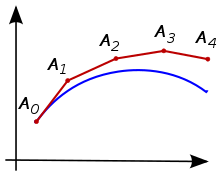
In numerical mathematics, one-step methods and multi-step methods are a large group of calculation methods for solving initial value problems. This problem, in which an ordinary differential equation is given together with an initial condition, plays a central role in all natural and engineering sciences and is also becoming increasingly important in the economic and social sciences, for example. Initial value problems are used to analyze, simulate or predict dynamic processes.
The basic idea behind one-step methods is that they calculate approximation points step by step along the desired solution, starting from the given starting point. They only use the most recently determined approximation for the next step, in contrast to multi-step methods, which also include points further back in the calculation. The one-step methods can be roughly divided into two groups: the explicit methods, which calculate the new approximation directly from the old one, and the implicit methods, which require an equation to be solved. The latter are also suitable for so-called stiff initial value problems.
The simplest and oldest one-step method, the explicit Euler method, was published by Leonhard Euler in 1768. After a group of multi-step methods was presented in 1883, Carl Runge, Karl Heun and Wilhelm Kutta developed significant improvements to Euler's method around 1900. These gave rise to the large group of Runge-Kutta methods, which form the most important class of one-step methods. Further developments in the 20th century include the idea of extrapolation and, above all, considerations on step width control, i.e. the selection of suitable lengths for the individual steps of a method. These concepts form the basis for solving difficult initial value problems, as they occur in modern applications, efficiently and with the required accuracy using computer programs.


